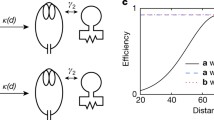Abstract
We provided parity-time symmetry (PT symmetry) for a magnetic resonance wireless power transfer (WPT) system designed to operate below 20 kHz. A lightweight coil having a mass of 39.1 g and consisting of a Mn–Zn ferrite core and 0.6-mm-diameter copper wire is considered herein. The coil had a Q factor of 111.5 at 16.5 kHz. The proposed system oscillated at 16.5 kHz for a transmission distance of 15 mm. A transmission power of 7.6 W was achieved when the DC power supply voltage was 100 V. Under these conditions, the power efficiency between the two coils was 92.1%. The oscillation frequency was automatically tuned to the optimal frequency for obtaining the maximum efficiency for a changing transmission distance. The relationship between the transmission power and the transmission distance was very different from that of a conventional WPT system, and an effect of PT symmetry clearly appeared.














Similar content being viewed by others
References
Jahromi AK, Hassan AU, Christodoulides DN, Abouraddy AF (2017) Statistical parity-time-symmetric lasing in an optical fibre network. Nat Commun 8:1359
Assawaworrarit S, Yu X, Fan S (2017) Robust wireless power transfer using a nonlinear parity-time symmetric circuit. Nature 546:387
Kurs A, Karalis A, Moffatt R, Joannopoulos JD, Fisher P, Soljačić M (2007) Wireless power transfer via strongly coupled magnetic resonances. Science 317:83–86
Karalis A, Joannopoulos JD, Soljačić M (2008) Efficient wireless non-radiative mid-range energy transfer. Ann Phys 323(1):34–48
Dong W, Li C, Zhang H, Ding L (2019) Wireless power transfer based on current non-linear PT-symmetric principle. IET Power Electron 12(7):1783–1791
Liu G, Zhang B (2018) Dual-coupled robust wireless power transfer based on parity-time-symmetric model. Chin J Elect Eng 4(2):50–55
Shu X, Zhang Bo (2018) Single-wire electric-field coupling power transmission using nonlinear parity-time-symmetric model with coupled-mode theory. Energies 11(3):532
Ishida H, Furukawa H, Kyoden T, Tanaka T (2017) Development of a wireless power transmission simulator based on finite-difference time-domain using graphics accelerators. IET Power Electron 10:1889–1895
Mizuno T, Takayama J, Ichioka T, Terashima M (1989) Decoupling control method of induction motor taking core loss into consideration. T IEE Jpn 109D:841–848 (in Japanese)
Jung J, Nam K (1998) A vector control scheme for EV induction motors with a series iron loss model. IEEE Trans Ind Elec 45(4):617–624
Ishida H, Kyoden T, Furukawa H (2019) Effectiveness of convolutional perfectly matched layer in time-domain numerical analysis of low frequency wireless power transfer. IEEJ J Ind Appl 8:131–139
Lee HH, Kang SH, Jung CW (2018) MR-WPT with reconfigurable resonator and ground for laptop application. IEEE Microw Wirel Compon Lett 28(3):269–271
Ishida H, Furukawa H (2015) Wireless power transmission through concrete using circuits resonating at utility frequency of 60 Hz. IEEE Trans Power Electron 30:1220–1229
Ishida H, Furukawa H, Kyoden T (2016) Development of design methodology for 60 Hz wireless power transmission system. IEEJ J Ind Appl 5:429–438
Ishida H, Kyoden T, Furukawa H (2018) Super-low-frequency wireless power transfer with lightweight coils for passing through a stainless steel plate. Rev Sci Instr 89(034706):1–11
Shi C, Dubois M, Chen Y, Cheng L, Ramezani H, Wang Y, Zhang X (2016) Accessing the exceptional points of parity-time symmetric acoustics. Nat Commun 7:11110
Liu Y, Hao T, Li W, Capmany J, Zhu N, Li M (2018) Observation of parity-time symmetry in microwave photonics. Light Sci Appl 7:38
Zhou J, Zhang B, Xiao W, Qiu D, Chen Y (2019) Nonlinear parity-time-symmetric model for constant efficiency wireless power transfer: application to a drone-in-flight wireless charging platform. IEEE Trans Industr Electron 66(5):4097–4107
Acknowledgements
The present research was supported in part by the Japan Society for the Promotion of Science, Kakenhi Grant Number 18K04115.
Funding
The Japan Society for the Promotion of Science, Kakenhi Grant Number 18K04115.
Author information
Authors and Affiliations
Contributions
Hiroki Ishida: theoretical analysis and development of WPT coils. Contribution ratio: 60%. Hiroto Furukawa: development of electric circuit. Contribution ratio: 20%. Tomoaki Kyoden: theoretical analysis of CMT. Contribution ratio: 20%.
Corresponding author
Ethics declarations
Conflict of interest
The authors declare that they have no competing interests.
Availability of data and material
All data are available from the corresponding author on reasonable request.
Code availability
Visual studio 2017 (visual C + +), TopSpice Circuit Simulator, LTspice Circuit Simulator, JMAG-Designer, MS-office Excel.
Consent for publication
All authors have agreed to publish from Electrical Engineering.
Additional information
Publisher’s Note
Springer Nature remains neutral with regard to jurisdictional claims in published maps and institutional affiliations.
Rights and permissions
About this article
Cite this article
Ishida, H., Furukawa, H. & Kyoden, T. Scheme for providing parity-time symmetry for low-frequency wireless power transfer below 20 kHz. Electr Eng 103, 35–42 (2021). https://doi.org/10.1007/s00202-020-01041-3
Received:
Accepted:
Published:
Issue Date:
DOI: https://doi.org/10.1007/s00202-020-01041-3




